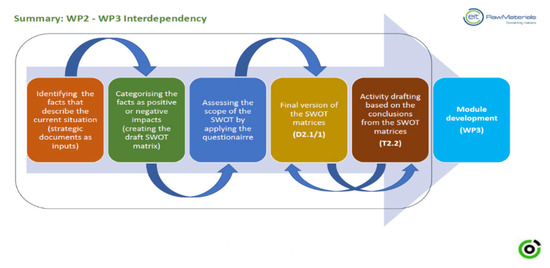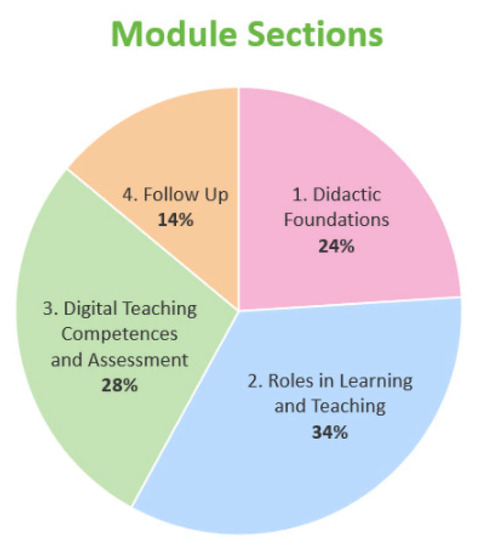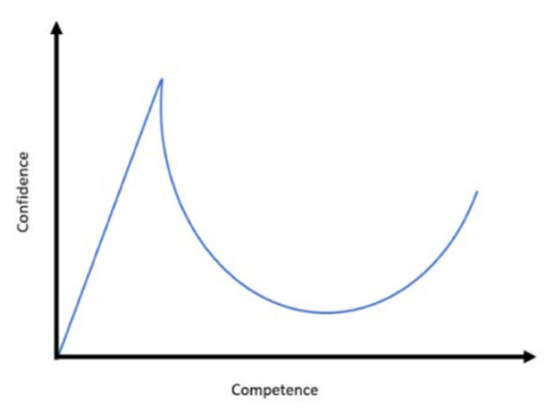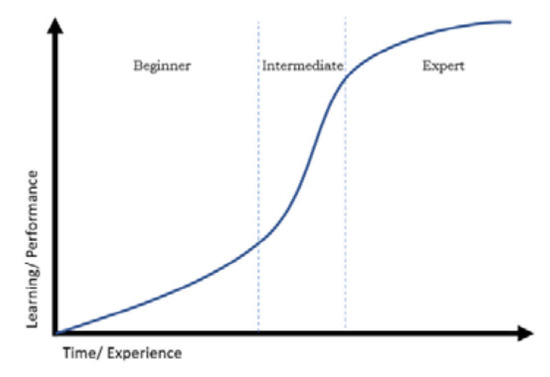Abstract
This article presents a methodology applied to the design of a tailor-made program for teaching staff that addresses the needs of high-level educational institutions in the Eastern and South-Eastern European (ESEE) region. The tailor-made program was implemented as a one-week online course for 22 “Trainees” from six ESEE universities earlier in 2021. “Trainees” from six participating universities are currently developing acceleration programs, planned to occur continuously until 2024, increasing the percentage of the trained academic staff to >50% at each of the six universities. During that period, 240 students will benefit from 140 improved RawMaterials-related courses, improving their learning and understanding.
1. Introduction
Closing the gap between research and the market and transferring scientific know-how and applied research results via successful market realizations is one of the main goals set by the European Commission for tackling ongoing societal challenges through a variety of programs and framework documents (e.g., European Union (EU) Research and Innovation Framework [1]). To reach this goal in the raw materials (RM) sector as prioritized by the EU, high-level education must equip future professionals with cross-disciplinary skills and empower them with key competences that encourage the application of lifelong learning practices and foster the development of an innovative and entrepreneurial mindset, as well as creative thinking and problem solving [2]. This sector provides more than 30 million jobs in the EU [3]. Support for educational staff and learners of all ages, non-formal and informal educational training, the creation of a suitable and sustainable learning environment, as well as the assessment and validation of competence development have to be ensured [4]. Due to its unique RM potential, the ESEE Region has been identified as a priority outreach area by EIT RawMaterials (EIT RM), a key European actor aiming to advance Europe’s transition into a sustainable economy in the RM sector [5,6]. Furthermore, the ESEE region has a population of approximately 180 million, and is characterized by its rapid development in technology and innovation [7]. Despite its huge potential and fast technological progression, its economic development is still greatly impacted by the former communist structures, which has led to a lagging transition in terms of modernization in comparison to other European nations that did not experience this regime. The lack of modern educational practices is simultaneously one of the consequences of the slowed-down economic prosperity, and one of the reasons for young professionals to seek for realization and professional development in Western Europe. To enhance the attractiveness of ESEE universities and create a growth environment for the high-educated workforce, a special tailor-made approach must be undertaken with the aim of providing solutions for the specific needs and gaps in higher education institutions there. This also concerns the necessity of advancing teaching and learning practices at a higher education level in the RM sector.
TrainESEE v.2 is a capacity-building project focused on the training and teaching of both young and experienced academic staff to advance their practices in science and teaching. Under the motto “train the trainers”, the project aims to empower them to co-develop tailor-made acceleration programs, and based on those, to subsequently train their own colleagues and thus enhance the teaching level in their home institutions. Within the scope of the project, six universities from the following countries were targeted and included as the “Trainees”: Bulgaria, Greece, Hungary, Poland, Slovakia, and Ukraine. Seven training partners from Austria, Finland, Greece, Hungary, Spain and Poland, the “Trainers”, were engaged in the task of examining the specific needs of the “Trainees” and developing a customized Teaching Methodology Module (TMM) training course, which was implemented as a 5-day online workshop consisting of 32 lectures accompanied by a syllabus for the development of follow-up acceleration programs. The workshop encompassed topics from didactic foundations, through roles in learning and teaching, to digital competences in teaching and assessment. For aligning the needs of the ESEE universities with the research and innovation needs at a national and international level, the following strategic documents were used as a basis: EIT RM Strategic Agenda 2018–2020, the RIS Strategy Document, the EIT RM Academy Consolidation Action Plan, the ESEE Education Note 2018, and the Intermin Deliverable and Competence documents.
2. Methods
The project consortium was coordinated by the University of Zagreb—Faculty of Mining, Geology and Petroleum Engineering. The following institutions were involved as the “Trainers”: Aalto University (Aalto), Tecnalia Research & Innovation (Tecnalia), KGHM Cuprum ltd. (KGHM), TU Wien (TUW), Montan University Leoben (MUL), National Technical University of Athens (NTUA), and the University of Miskolc (UM). The following universities were involved as the “Trainees”: University of Mining and Geology “St. Ivan Rilski” (UMG), National Technical University of Athens (NTUA), University of Miskolc (UM), AGH University of Science and Technology (AGH), Technical University of Košice (TUKE), and Dnipro University of Technology (Dnipro).
The project team recognized two levels of beneficiaries of the TrainESEE v.2 project: (1) direct beneficiaries: universities and academic staff/associates/lecturers at RM-related study programs at the “Trainee” institutions and other Regional Innovation Scheme (RIS) ESEE and European universities, as well as EIT RM, and (2) final beneficiaries (end-users): students enrolled at RM programs from participating RIS ESEE universities and sector-specific industry from the ESEE region.
The specific needs were identified via a Strengths, Weaknesses, Opportunities, and Threats (SWOT) analysis (Figure 1). Upon this basis, the “Trainee” universities provided sound evidence on their education needs, namely: new teaching techniques for the teaching staff (problem/case-based learning), improvement of the soft skills of students, enhancement of students’ motivation, practical and communication skills for teachers/students, communication technologies, digital teaching tools and methods, assessment of students. The “Trainees” evaluated and prioritized their most important needs: education techniques/methods—competence, rhetoric, confidence, digital resources in didactics, digital tools for teaching, evaluation skills, content and language integrated learning.

Figure 1.
Visual scheme of the SWOT analysis basis.
The goals of the TMM were subsequently adjusted to the needs and formulated as follows: to enhance the didactical skills of the teaching staff, to develop tailor-made educational techniques based on didactical methods, to strengthen online teaching techniques by introducing advanced digital resources in didactics, to enhance evaluation and assessment skills as well as efficient supervision, to help higher education institutions towards a sustainable and competitive position by capacity building modules, to create and develop tailor-made acceleration programs.
The acceleration programs are planned to take place continuously for a minimum of 3 years, increasing the percentage of the trained academic staff to >50% at each of the “Trainee” universities. During that period, the consortium estimates that about 240 students will benefit from 140 improved RM-related courses, increasing their level of teaching and learning as well as the outcome of those practices. As a result, it is expected that the overall ranking of the participating universities will increase by 12%.
The learning outcomes of the TMM were defined based on the knowledge, skills and competences intended to be acquired by the attendees after completing the course: to increase fundamentals of didactical knowledge and course planning/design, to formulate learning outcomes, to select and apply suitable assessment strategies, to apply techniques to enhance self-motivation and student motivation, to identify challenges and possible preventive and situational solutions, to know and understand Generation X features, to apply the method of problem-based learning and case study for teaching, to connect better with the students, to set goals and learn how to assess the knowledge process, to evaluate students through interaction and feedback.
The structure of the TMM was built on the defined learning outcomes and consisted of tailor-made lecture units with an overall of 30%/70% theoretical/practical part, segmented into four major sections: 1. Didactic Foundations, 2. Roles in Learning and Teaching, 3. Digital Teaching Competences and Assessment, 4. Follow Up (Figure 2). Section 4 was purposed to enable the achievement of a sustainable and competitive position by creating capacity-building modules and deploying them within the home institutions.

Figure 2.
Structure of the TMM.
Methodologically, the TMM involved presentations, instructive discourse, exercises, case studies, best-case examples, group work, individual work, and discussion and collegial exchange. The working environment consisted of videos, worksheets, case studies, group discussions and individual work, handouts, digital pinboard, games, interactive whiteboard, application, and design thinking. The lecture units of the TMM were developed and delivered by seven international trainers (coaches) who were experts and/or professional instructors with background/expertise in didactics, pedagogy, life-long learning, adult education, marketing, economics and psychology.
- Didactic Foundations: fundamentals of didactics, course planning/design (through Constructive Alignment methodology), communication, cooperation skills, assessment strategies (duration: 6 h 30 min);
- Roles in Learning and Teaching: methodology of problem-based learning, the impact of own learning biography on teaching style, theoretical basics on teaching and learning, student motivation and self-motivation as a teacher, didactical challenges in teaching situations, identifying Generation X SWOT, the new role of the lecturer and students, gamification (duration: 9 h and 15 min);
- Digital Teaching Competences and Assessment: introduction to Mixed Reality (MR), reflecting on students’ needs, the suitability of certain media, discussion of challenges and opportunities of MR, assessment/evaluation theory, student/educator motivation, stimulating participation, tools, metrics, assistants for assessment, project-based learning, presentation skills, assessment and evaluation theory (duration: 7 h and 25 min).
3. Results and Discussion
The Didactic Foundations section focused on using Constructive Alignment to design a teaching course based on predefined learning outcomes. The “Trainees” were encouraged to work in collaboration and analyze underlying general didactic beliefs, develop an understanding of the relevance and correct formulation of learning outcomes, and subsequently individually produce their own such statements for one of their university courses.
The Roles in Learning and Teaching section focused on teaching methodologies attributed to the evidence-based theory of learning and teaching. Within this section, the “Trainees” were introduced to three different sub-theories: cognitive load theory, retrieval practice theory, and self-determination theory. The Socratic method was used to frame the subjectivity of learning as a process. The “Trainees” discussed/identified various methods and techniques for enhancing student and teacher motivation, understanding the features of Generation X, and implying gamification elements.
The Digital Teaching Competences section focused on the integration of digital technologies in teaching, since although digitalization is rapidly increasing, teaching remains highly dependent on traditional methods [8]. The “Trainees” received an introduction to MR in teaching and media literacy skills. An application was developed to provide a hands-on experience with MR following the experiential learning concept [9].
The Assessment section discussed assessment as a vital part of the learning process. The student’s experience from classical evaluation tests and examination procedures is linked to increased anxiety and works contra-productive to the teachers’ goals and efforts for increasing the knowledge basis of their students [10,11,12]. This is the reason professors, trainers and educators must nowadays take the role of a coach more than ever. A pathway for assessing knowledge and skills, based on the latest developments including digital tools (e.g., plagiarism checking tools) was presented and discussed with the purpose to encourage a coaching approach and to use assessment strategies and digital tools to support a creative knowledge gain for students and thus boost their knowledge curve (Figure 3 and Figure 4), how to properly use the currently available suitable electronic tools, and to follow modern evaluation approaches [11,12,13,14]. Another methodology discussed within this section was project-based learning. Following this approach instructors can construct their own pathway enhancing their students’ experience and boosting their learning curve.

Figure 3.
Dunning–Kruger effect [14].

Figure 4.
Learning curve [11].
4. Conclusions
The TMM Workshop aimed at building a new educational collaborative network between the RIS ESEE universities, non RIS universities and research institutes, as well as at strengthening the networks within the RIS ESEE universities themselves, and contributing to building, training and connecting the ESEE education and scientific community.
The attendees at the TMM workshop acquired the following skills, and respectively gained the following competences:
- In the area of Didactic Foundations: professional competence: extended expertise related to didactics in general and course planning in particular; method competence: e.g., increased problem-solving skills, ability to transfer knowledge; social competence: e.g., deepened communication skills, cooperation skills; self-competence: e.g., ability and readiness for further development, self-management, strengthening professional attitudes and values, professional identity;
- In the area of Roles in Learning and Teaching: discovering different aspects of teaching personalities, selection and sharing of individual learning biography, reflection upon teaching beliefs, main elements of three learning theories, reflection on own teaching contexts, three main factors for motivation and methodical ways to enhance teacher and student motivation, everyday teaching challenges and application of preventive and situational solutions, better lecture planning, organizing, cooperation, communication and group-working competence;
- In the area of Digital Teaching Competences and Assessment: technical competence to handle and use MR technologies confidently, didactic competence to choose the right technology for a certain learning goal, methodical competence to identify and develop application areas of MR, organization of assessment processes, awareness of available evaluation tools, soft skills development.
Based on these skills and competences, the attendees are expected: (i) to apply this knowledge in their own teaching fields of RM subjects, and (ii) (for the senior attendees) to transfer the knowledge and to act as knowledge facilitators at their home universities by supporting the development of similar tailor-made teaching methodology acceleration programs. This will enhance the teaching level and learning practices generally at their home institutions, encourage the application of lifelong learning practices and will effectively increase the quality and overall competitiveness of the high education in the RM sector in the ESEE Region in a sustainable manner. Consequently, it will equip the students (future professionals) with cross-disciplinary skills and empower them with key competences that encourage and foster the development of an innovative and entrepreneurial mindset.
Author Contributions
E.Y.: conceptualization; methodology; resources; writing—original draft preparation; visualization; project administration; S.P.: conceptualization; methodology; resources; writing—original draft preparation; visualization; L.D.: conceptualization; methodology; resources; writing—original draft preparation; S.B.Š.: conceptualization; validation; resources; writing—original draft preparation; writing—review and editing; supervision; visualization; funding acquisition; I.M.: conceptualization; methodology; validation; resources; writing—original draft preparation; writing—review and editing; supervision; funding acquisition. All authors have read and agreed to the published version of the manuscript.
Funding
This research was funded by the European Institute of Innovation and Technology (EIT), a body of the European Union, under the Horizon 2020, the EU Framework Programme for Research and Innovation, grant number 19159.
Institutional Review Board Statement
Not applicable.
Informed Consent Statement
Not applicable.
Data Availability Statement
EIT Raw Materials Infocenter Workspace Files (restricted area) https://infocenter-alt.eitrawmaterials.eu/group/trainesee-v.2-implementation/workspacefiles (accessed on 31 December 2021).
Acknowledgments
The authors acknowledge participation of the TrainESEE consortia and industrial reviewers, tailoring the final version of the Techning methodology module.
Conflicts of Interest
The authors declare no conflict of interest. The funders had no role in the design of the study; in the collection, analyses, or interpretation of data; in the writing of the manuscript, or in the decision to publish the results.
References
- Framework Programmes for Research and Technological Development. Available online: https://en.wikipedia.org/wiki/Framework_Programmes_for_Research_and_Technological_Development (accessed on 31 December 2021).
- Available online: https://ec.europa.eu/growth/sectors/raw-materials_en (accessed on 31 December 2021).
- The Raw Materials Initiative—Meeting Our Critical Needs for Growth and Jobs in Europe, Communication from the Commission to the European Parliament and the Council {SEC(2008) 2741}. Available online: https://eur-lex.europa.eu/legal-content/EN/TXT/PDF/?uri=CELEX:52008DC0699&from=EN (accessed on 31 December 2021).
- Commission Staff Working Document accompanying the document Proposal for a Council Recommendation on Key Competences for Lifelong Learning {COM(2018) 24 Final}. 17 January 2018. Available online: https://eur-lex.europa.eu/legal-content/EN/TXT/PDF/?uri=CELEX:52018SC0014&from=EN (accessed on 31 December 2021).
- The Future of Raw Materials Higher Education Conference and Ideation. Available online: https://eitrawmaterials.eu/the-future-of-raw-materials-higher-education/ (accessed on 13 August 2021).
- EIT Raw Materials Strategic Agenda 2021–2027: The EIT—Making Innovation Happen; European Institute of Innovation and Technology (EIT): Berlin, Germany, 15 March 2021; Available online: https://eitrawmaterials.eu/wp-content/uploads/2021/04/Annex-1-EIT-RawMaterials_Strategic-Agenda_2021-2027.pdf (accessed on 31 December 2021).
- ESEE Education Concept Note—A Report on How to Increase Innovation Capacity of ESEE Region through Education Activity in the Raw Material Sector. 2018. Available online: https://trainesee2.eu/wp-content/uploads/2020/08/ESEE-Education-Concept-Note_20181001.pdf (accessed on 31 December 2021).
- Daling, L.; Kommetter, C.; Abdelrazeq, A.; Ebner, M.; Ebner, M. Mixed Reality Books: Applying Augmented and Virtual Reality in Mining Engineering Education. In Augmented Reality in Education; Springer: Cham, Switzerland, 2020; pp. 185–195. [Google Scholar]
- Kolb, D.A. Experiential Learning: Experience as the Source of Learning and Development; FT Press: Upper Saddle River, NJ, USA, 2014. [Google Scholar]
- Putwain, D. Examination stress and test anxiety. Psychologist 2008, 21, 1026–1029. [Google Scholar]
- Mohamadi, M.; Alishahi, Z.; Soleimani, N. A Study on Test Anxiety and Its Relationship to Test Score and Self-actualization of Academic EFL Students in Iran. Procedia-Soc. Behav. Sci. 2014, 98, 1156–1164. [Google Scholar] [CrossRef] [Green Version]
- Weeks, N.; Lewis, R.; Patel, F.; Garrison-Jakel, J.; Berger, D.E.; Lupien, S.J. Examination stress as an ecological inducer of cortisol and psychological responses to stress in undergraduate students. Stress 2006, 9, 199–206. [Google Scholar] [CrossRef] [PubMed]
- Garcia, A.S.; Garciaq-Alvarez, M.-T.; Moreno, B. Analysis of assessment opportunities of learning spaces: On-line versus face to face methodologies. Comput. Hum. Behav. 2013, 30, 372–377. [Google Scholar] [CrossRef]
- Kruger, J.; Dunning, D. Unskilled and Unaware of It: How Difficulties in Recognizing One’s Own Incompetence Lead to Inflated Self-Assessments. J. Personal. Soc. Psychol. 1999, 77, 1121–1134. [Google Scholar] [CrossRef]
Publisher’s Note: MDPI stays neutral with regard to jurisdictional claims in published maps and institutional affiliations. |
© 2022 by the authors. Licensee MDPI, Basel, Switzerland. This article is an open access article distributed under the terms and conditions of the Creative Commons Attribution (CC BY) license (https://creativecommons.org/licenses/by/4.0/).